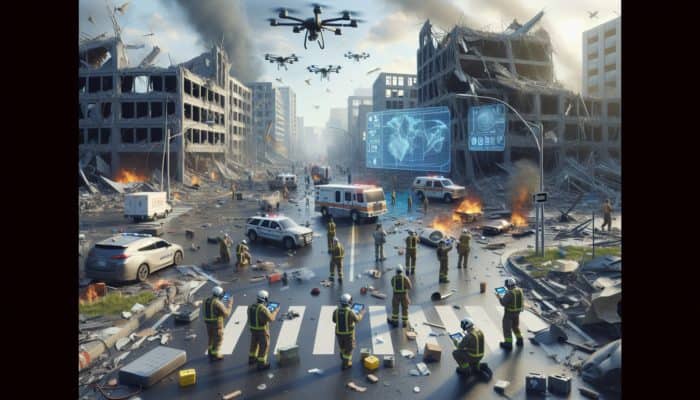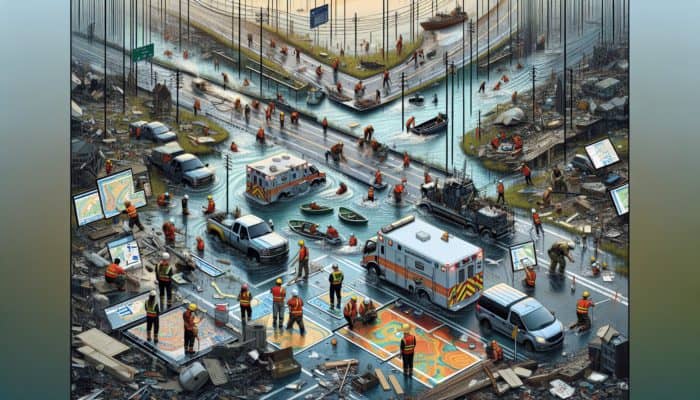Enhance Your Skills in Navigating Post-Disaster Environments Effectively
Understanding the Key Aspects of Navigation After Disasters

Post-disaster navigation involves a comprehensive array of techniques and tools specifically tailored to effectively move through and manage regions devastated by catastrophic events. This critical component of disaster management is focused on safeguarding both emergency responders and affected communities, enabling them to navigate hazardous environments with enhanced safety and efficiency. The primary elements of post-disaster navigation consist of:
- Assessment of impacted regions to determine safety levels
- Mapping secure transit routes to facilitate movement
- Identification of essential resources and services available for aid
- Coordination with emergency service personnel to ensure unified efforts
- Utilization of technology for real-time situational awareness and updates
- Community engagement to leverage local knowledge and expertise
- Training and preparedness initiatives to keep responders skilled and informed
These components collaboratively establish a robust navigation framework that is adaptable to the unpredictable conditions typically encountered in post-disaster scenarios. Ensuring that responders are equipped with the necessary tools and information greatly improves the chances of successful navigation and effective recovery operations.
Essential Technologies for Streamlined Post-Disaster Navigation
The integration of technological advancements is crucial for enhancing the efficiency of post-disaster navigation. Various tools empower responders to quickly assess situations, chart effective routes, and communicate seamlessly. The technologies that are central to the navigation process include:
- Global Positioning Systems (GPS) for precise location tracking and navigation
- Drones for comprehensive aerial mapping and surveillance
- Satellite imagery for detailed analysis of extensive terrains
- Mobile applications for real-time updates, alerts, and information sharing
- Geographic Information Systems (GIS) for advanced data visualization and spatial analysis
- RFID tags to facilitate efficient tracking of resources and supplies
- Emergency communication systems to maintain connectivity under adverse conditions
These technologies empower responders to swiftly evaluate disaster-affected regions, providing essential insights that can significantly influence decision-making processes. For instance, drones can offer aerial views of locations that are difficult to reach on foot, while GIS technology aids in analyzing spatial data to identify the safest pathways for evacuation or the distribution of essential supplies.
The Critical Role of Accurate Mapping in Effective Navigation
Accurate mapping serves as a fundamental pillar of successful post-disaster navigation, allowing for the identification of safe routes and critical locations such as shelters, hospitals, and supply depots. Often, reliance on outdated or incomplete maps can result in dangerous miscalculations. For example, during the 2010 earthquake in Haiti, the use of updated mapping technologies enabled relief agencies to locate stranded individuals urgently in need of assistance.
Furthermore, advanced mapping techniques such as LiDAR and remote sensing have proven to be instrumental in generating detailed topographic maps that reflect changes in terrain caused by disasters. These maps are not only vital for navigation but are also crucial for effective recovery planning. Insights gained from these mapping initiatives have driven the evolution of improved practices in post-disaster navigation, underscoring the necessity of accuracy and real-time data in disaster response efforts.
Confronting and Overcoming Challenges in Post-Disaster Navigation

Identifying Common Challenges in Post-Disaster Navigation
Navigating through landscapes that have been fundamentally altered by disasters poses numerous challenges. Common obstacles include severely damaged infrastructure, breakdowns in communication, and the absence of real-time data. Infrastructure often suffers extensive damage, leaving roads obstructed, bridges unusable, and buildings collapsed, rendering traditional navigation methods not only ineffective but also hazardous.
In addition, communication barriers can severely hinder recovery efforts. Post-disaster, cellular networks may become inoperative, and conventional communication methods may quickly lose reliability. Moreover, the lack of real-time data can result in significant delays in response times, making it challenging for navigators to make informed decisions. These hurdles necessitate the adoption of innovative and adaptable strategies to ensure safe navigation and effective responses in areas devastated by disasters.
Strategies to Mitigate Communication Barriers in Disaster Scenarios
Effective communication is critical for coordinating navigation efforts during and after a disaster. To address communication barriers, various strategies can be implemented. Utilizing satellite phones ensures that individuals can maintain contact, regardless of the reliability of local cellular networks. Establishing temporary communication networks, such as mesh networks or collaborating with amateur radio operators, can facilitate the exchange of information among responders.
Additionally, training individuals on emergency communication protocols can significantly enhance coordination during crises. Community workshops that focus on emergency communication techniques can build resilience and ensure that residents are equipped to disseminate information effectively. By leveraging technology and local resources, communication gaps can be bridged efficiently, leading to improved navigation and response efforts.
Navigating Infrastructure Damage Effectively in Disaster Scenarios

Infrastructure damage represents a significant challenge when navigating in post-disaster scenarios. Responders often need to identify alternative routes when primary roads become impassable. By utilizing technology such as GPS and advanced mapping applications, they can discover alternative paths that may not be immediately visible.
Temporary solutions, such as deploying portable bridges or utilizing ferries in flooded areas, can facilitate movement across compromised landscapes. Collaborating with local authorities and agencies provides invaluable insights regarding the current state of infrastructure, enabling navigators to adapt their strategies in real-time. By emphasizing adaptability and resourcefulness, navigators can efficiently tackle the challenges posed by infrastructure damage during disaster scenarios.
The Importance of Real-Time Data in Navigation
Real-time data plays a pivotal role in enhancing post-disaster navigation by providing critical insights into current road conditions and potential hazards. Technologies that deliver immediate information, such as traffic monitoring systems and drone imagery, are vital for improving situational awareness.
For instance, in the aftermath of Hurricane Harvey in 2017, responders utilized real-time data to assess flooding conditions and adjust team deployments accordingly. By integrating multiple data sources, navigators can effectively plan routes that prioritize safety and efficiency. This data-driven approach fosters informed decision-making and agile responses to the rapidly changing conditions typically encountered in post-disaster environments.
Insightful Expert Recommendations for Optimizing Navigation After Disasters
Best Practices Recommended by Experienced Navigators
Experienced navigators offer invaluable insights into strategies that yield the most effective results for traversing disaster zones. Recommended best practices include conducting thorough pre-disaster planning, which involves gaining a comprehensive understanding of the area’s geography, identifying critical resources, and establishing robust communication protocols before disaster strikes.
Another actionable step is to engage with local communities to tap into their regional knowledge. Involving community members in planning processes enhances situational awareness and optimizes resource allocation. Additionally, employing technology to keep maps current and continuously training responders in navigation protocols ensures ongoing preparedness. Organizations such as the Red Cross frequently conduct drills to reinforce these practices, equipping responders with the necessary skills to navigate post-disaster landscapes successfully.
Emerging Research Findings in Navigation Techniques
Recent studies in the field of post-disaster navigation have focused on integrating artificial intelligence and machine learning to analyze data patterns and predict the most effective routes in dynamic situations. This advancement provides responders with predictive capabilities that enhance their situational awareness and improve decision-making processes.
Research indicates that incorporating community feedback into navigation strategies leads to more effective disaster responses. Engaging local knowledge not only improves navigation but also strengthens community resilience. As research continues to evolve, these findings will shape future practices, emphasizing the significance of a multifaceted approach that combines technology with human insights in post-disaster navigation.
Illustrative Case Studies of Successful Navigation Approaches
Case studies provide rich insights into effective navigation strategies employed following disasters. A notable example is the navigation efforts during the 2011 Tōhoku earthquake and tsunami in Japan, where first responders effectively utilized a combination of satellite imagery and local knowledge to assess damage and establish routes for search and rescue missions.
Another compelling case study is the response to the 2015 Nepal earthquake, where the deployment of drones significantly expedited the mapping of affected areas. This innovative technology enabled responders to identify critical locations for aid distribution while navigating hazardous terrains. These real-world examples underscore the necessity for adaptive strategies and technological integration to enhance navigation efficacy following disasters.
The Impact of Technological Innovations on Navigation Tools
Technological innovations have greatly enhanced navigation capabilities in post-disaster scenarios. Emerging tools, such as augmented reality (AR) applications, empower navigators to overlay critical information onto their surroundings in real-time. This technology can provide directions, highlight hazards, and identify resources, significantly improving situational awareness.
Furthermore, the development of mobile apps tailored for disaster response facilitates seamless communication and data sharing among teams. These advancements not only improve navigation efficiency but also promote a more coordinated approach to disaster recovery. As new technologies emerge, their integration into navigation practices will lead to more effective and safer navigation strategies in the face of disasters.
Crucial Resources and Tools for Effective Navigation in Post-Disaster Situations
Key Navigation Equipment Essential for Disaster Response
Equipping oneself with the right tools is vital for effective navigation in post-disaster environments. Essential navigation equipment includes:
- GPS devices for accurate location tracking
- Compasses to assist in orienting oneself in unfamiliar areas
- Physical maps as reliable backups to digital systems
- Emergency beacons for signaling distress in emergencies
- Multi-tools for various on-ground needs
- First aid kits to address immediate medical emergencies
- Portable chargers to ensure electronic devices remain powered
These tools empower responders to navigate safely and efficiently, ensuring they are well-prepared for a variety of challenges that may arise in post-disaster scenarios. Proper training in the use of this equipment is equally essential, enabling responders to maximize the resources at their disposal.
Software Solutions That Enhance Navigation Efficiency
Several software solutions can significantly boost navigation efforts in disaster-affected regions. Geographic Information Systems (GIS) deliver essential mapping and spatial analysis capabilities, enabling responders to visualize data and identify crucial patterns during crises.
Moreover, mapping applications designed for offline use ensure accessibility even when internet connectivity is compromised. Platforms like ArcGIS or OpenStreetMap assist navigators in creating and updating maps that accurately reflect real-time conditions on the ground. By leveraging these software solutions, agencies can enhance their operational efficiency and responsiveness in post-disaster navigation.
Enhancing Navigation Effectiveness Through Training and Preparedness Programs
Comprehensive training initiatives are fundamental for equipping individuals with the necessary skills to navigate effectively in disaster scenarios. These programs often include hands-on exercises, simulations, and real-world scenarios designed to develop practical skills. For instance, the FEMA Community Education and Training program empowers community members with vital navigation techniques and emergency response knowledge.
Additionally, organizations frequently collaborate with local governments to create tailored training initiatives that address specific regional challenges. These programs benefit not only emergency responders but also empower communities to navigate effectively after disasters. By investing in training and preparedness, organizations can build a more resilient response network equipped to handle future challenges.
Implementing Post-Disaster Navigation Strategies
Crucial Initial Steps for Assessment and Planning
The initial phase of post-disaster navigation involves assessing the impact of the disaster and planning navigation routes accordingly. This assessment is crucial for determining the extent of the damage and identifying accessible pathways. For example, after Hurricane Katrina in 2005, initial assessments conducted by the National Guard were vital in establishing safe evacuation routes for displaced residents.
Effective planning necessitates collaboration with various agencies to gather comprehensive data, ensuring that all efforts are coordinated and well-informed. Engaging local authorities and community leaders can provide additional insights into the landscape and potential hazards, further enriching the planning process. By prioritizing thorough assessments, responders can develop effective navigation strategies that address the unique challenges presented by each disaster.
Key Steps Involved in Executing Navigation
Post-disaster navigation consists of several critical steps that ensure safe passage to intended destinations. The first step involves route planning, utilizing maps, technology, and local knowledge to identify viable paths. Responsive navigation necessitates real-time adjustments based on updated information regarding obstacles or hazards, allowing for flexible routing.
Another vital step is ensuring safe passage to destinations, which often requires coordination with emergency services to provide necessary assistance and resources along the route. This may involve establishing check-in points for safety and communication purposes. By adhering to these structured steps, navigators can create a systematic approach to effectively managing the complexities inherent in post-disaster environments.
Why Collaboration with Emergency Services Is Essential
Collaboration with emergency services is paramount for ensuring successful navigation during disaster response efforts. Such cooperation guarantees that navigation strategies align with broader rescue and recovery operations, facilitating a cohesive response to the challenges encountered.
Regular communication with emergency services allows navigators to receive real-time updates about conditions, hazards, and operational requirements. Joint training exercises can also enhance collaboration, fostering relationships between navigators and emergency personnel. By prioritizing coordination, responders can work collectively to improve safety and efficiency in navigating disaster-affected areas.
The Advantages of Effective Navigation Post-Disaster
Enhancing Safety Through Effective Navigation
Effective post-disaster navigation significantly enhances safety by identifying reliable routes and avoiding potential hazards. This safety advantage is crucial not only for responders but also for displaced residents seeking assistance or evacuation.
By utilizing accurate maps and real-time data, navigators can avoid blocked roads, flooding, or other dangers. For instance, during the 2019 Mozambique Cyclone Idai response, efficient navigation efforts enabled rescuers to safely reach isolated communities, ultimately saving lives. Prioritizing safety in navigation bolsters overall disaster response effectiveness, reinforcing its vital role in recovery efforts.
The Influence of Navigation on Economic and Social Recovery
Effective navigation also has significant economic and social implications in post-disaster contexts. By ensuring access to essential services such as healthcare, food, and shelter, navigation mitigates economic losses and supports community recovery.
Furthermore, facilitating movement within affected areas promotes social cohesion and enhances resilience. For example, following the 2017 Mexico earthquake, effective navigation facilitated swift resource distribution and community engagement, thereby improving recovery efforts. By addressing both economic and social dimensions, effective navigation strategies play a pivotal role in rebuilding communities after disasters.
Supporting Recovery Efforts Through Navigation
Effective navigation directly aids urgent recovery efforts following disasters. Enabling movement allows for the timely delivery of aid and resources to impacted areas. Prompt access to critical supplies enables communities to initiate the recovery process more quickly, ultimately reducing long-term impacts.
Additionally, effective navigation assists in the safe return of displaced individuals to their homes. By ensuring that secure routes are available, navigators can help restore a sense of normalcy and stability within communities. These improved recovery efforts are crucial for rebuilding lives and ensuring that communities emerge stronger and more resilient in the aftermath of disasters.
Strategies for Enhancing Post-Disaster Navigation
Implementing Effective Planning Techniques
Improving post-disaster navigation necessitates the adoption of effective planning techniques. Scenario planning is a vital method that involves anticipating potential disaster situations and developing navigation strategies accordingly. This proactive approach prepares responders for a range of challenges, ensuring they can adapt swiftly to evolving conditions.
Incorporating real-time data integration into navigation planning further enhances responsiveness. Access to current information allows for dynamic route adjustments, ensuring safety and efficiency. Training responders to effectively utilize these planning techniques equips them with the skills necessary to navigate complex post-disaster environments successfully.
Leveraging Community Knowledge for Improved Navigation
Utilizing local knowledge can significantly enhance navigation efforts in post-disaster scenarios. Community members often possess invaluable insights into the geography, infrastructure, and potential hazards of their areas. Involving these individuals in navigation planning fosters collaboration and strengthens response strategies.
Workshops and community meetings can serve as platforms for gathering input and sharing knowledge. This engagement not only sharpens navigation strategies but also empowers communities, fostering resilience and preparedness for future disasters. By prioritizing community involvement, organizations can significantly enhance the effectiveness of their navigation efforts.
The Importance of Continuous Improvement and Feedback Mechanisms
Continuous improvement is essential for refining post-disaster navigation strategies. Implementing feedback loops allows organizations to evaluate the effectiveness of their navigation efforts and identify areas for enhancement. Gathering insights from navigators, emergency responders, and community members creates a comprehensive understanding of the challenges faced during navigation.
Regular debriefing sessions after disasters enable teams to analyze successes and failures, informing future strategies. This commitment to continuous improvement ensures that navigation approaches adapt based on lessons learned from past experiences, enhancing overall effectiveness in disaster response.
Emerging Trends in Post-Disaster Navigation
Anticipated Innovations on the Horizon
The future of post-disaster navigation is poised to witness exciting innovations. Emerging technologies, such as AI-driven navigation systems, are expected to revolutionize how responders assess and navigate disaster-affected areas. These advancements will enhance situational awareness, allowing for more informed decision-making and optimal resource allocation.
Additionally, integrating real-time data analytics into navigation systems holds the potential for predicting hazards and dynamically optimizing routes. As these innovations develop, they will furnish responders with unprecedented capabilities, significantly improving navigation efficiency and safety in post-disaster scenarios.
The Role of Autonomous Vehicles in Future Navigation Efforts
Autonomous vehicles are projected to play a crucial role in future post-disaster navigation efforts. These vehicles can operate in hazardous environments, providing essential transportation for responders and supplies while safeguarding human safety.
Moreover, autonomous drones can perform aerial assessments, transmitting vital information to navigation teams while avoiding ground obstacles. As this technology evolves, its integration into disaster response strategies has the potential to dramatically enhance operational efficiency and safety, transforming the landscape of post-disaster navigation.
Necessary Steps for Future Disaster Preparedness
Preparing for future disasters involves incorporating new technologies and strategies into navigation plans. Investing in research and development will drive innovation, ensuring that responders are equipped with state-of-the-art tools and knowledge.
Moreover, fostering partnerships among technology providers, emergency services, and communities will create a collaborative approach to disaster preparedness. By prioritizing proactive measures and continuous training, organizations can strengthen their resilience and responsiveness to future disasters, ultimately improving the effectiveness of post-disaster navigation.
Frequently Asked Questions (FAQs) About Post-Disaster Navigation
What does post-disaster navigation entail?
Post-disaster navigation refers to the methods and tools employed to navigate and manage areas following a catastrophic event, ensuring the safe and efficient movement of responders and affected individuals.
Why is accurate mapping essential in post-disaster navigation?
Accurate mapping is critical for identifying safe routes and essential locations, which enables effective disaster response and supports recovery efforts.
What are common obstacles faced in post-disaster navigation?
Common challenges include damaged infrastructure, communication breakdowns, and a lack of real-time data, all of which complicate navigation efforts in disaster scenarios.
How can communication barriers be effectively addressed?
Strategies include utilizing satellite phones, establishing temporary networks, and training individuals in emergency communication protocols to enhance overall coordination.
What technologies are pivotal in enhancing post-disaster navigation?
Key technologies encompass GPS devices, drones, satellite imagery, GIS software, and mobile applications, providing real-time data and mapping capabilities essential for effective navigation.
How can local knowledge contribute to navigation efforts?
Local knowledge offers valuable insights into the geography and potential hazards of an area, thereby improving navigation strategies and fostering community resilience.
What are the best practices for effective post-disaster navigation?
Best practices include thorough pre-disaster planning, engaging local communities, utilizing real-time data, and ensuring proper training for responders to enhance navigation efficiency.
How do continuous improvement strategies function for navigation?
Continuous improvement involves implementing feedback loops to evaluate navigation efforts, analyze successes and failures, and adapt strategies for future responses effectively.
What role do autonomous vehicles have in post-disaster navigation?
Autonomous vehicles can operate in hazardous environments, transporting responders and supplies safely, while drones can conduct aerial assessments to assist navigation efforts.
What future trends are anticipated in post-disaster navigation?
Innovations such as AI-driven navigation systems and real-time data analytics will enhance situational awareness and improve navigation efficiency during disaster responses.
Discover our journey on X!
The post Post-Disaster Navigation: Essential Strategies appeared first on Survival Bite.
The Article Essential Strategies for Post-Disaster Navigation Was Found On https://limitsofstrategy.com

